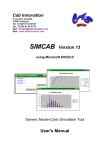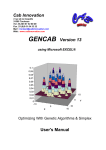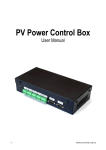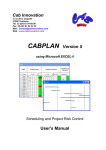Download Freescale Semiconductor MOTOROLA 94001480400/D User's Manual
Transcript
Freescale Semiconductor, Inc. ARCHIVED BY FREESCALE SEMICONDUCTOR, INC. 2005 Freescale Semiconductor, Inc... ARCHIVED BY FREESCALE SEMICONDUCTOR, INC. 2005 Bluetooth Headset User’s Guide 94001480400/D Rev. 1.5, 2002-09-02 For More Information On This Product, Go to: www.freescale.com Freescale Semiconductor, Inc. ARCHIVED BY FREESCALE SEMICONDUCTOR, INC. 2005 Freescale Semiconductor, Inc... ARCHIVED BY FREESCALE SEMICONDUCTOR, INC. 2005 Motorola reserves the right to make changes without further notice to any products herein. Motorola makes no warranty, representation or guarantee regarding the suitability of its products for any particular purpose, nor does Motorola assume any liability arising out of the application or use of any product or circuit, and specifically disclaims any and all liability, including without limitation consequential or incidental damages. “Typical” parameters which may be provided in Motorola data sheets and/or specifications can and do vary in different applications and actual performance may vary over time. All operating parameters, including “Typicals” must be validated for each customer application by customer’s technical experts. Motorola does not convey any license under its patent rights nor the rights of others. Motorola products are not designed, intended, or authorized for use as components in systems intended for surgical implant into the body, or other applications intended to support life, or for any other application in which the failure of the Motorola product could create a situation where personal injury or death may occur. Should Buyer purchase or use Motorola products for any such unintended or unauthorized application, Buyer shall indemnify and hold Motorola and its officers, employees, subsidiaries, affiliates, and distributors harmless against all claims, costs, damages, and expenses, and reasonable attorney fees arising out of, directly or indirectly, any claim of personal injury or death associated with such unintended or unauthorized use, even if such claim alleges that Motorola was negligent regarding the design or manufacture of the part. The Bluetooth trademarks are owned by their proprietor and used by Motorola, Inc., under license. All other product or service names are the property of their respective owners. © Motorola, Inc. 2003. Motorola and are registered trademarks of Motorola, Inc. Motorola, Inc. is an Equal Opportunity/Affirmative Action Employer. How to reach us: USA/EUROPE/Locations Not Listed: Motorola Literature Distribution; P.O. Box 5405, Denver, Colorado, 80217. 1–303–675–2140 or 1–800–441–2447 JAPAN: Motorola Japan Ltd.; SPS, Technical Information Center, 3–20–1, Minami–Azabu, Minato–ku, Tokyo 106–8573 Japan. 81–3–3440–3569 ASIA/PACIFIC: Motorola Semiconductors H.K. Ltd., Silicon Harbour Centre, 2 Dai King Street, Tai Po Industrial Estate, Tai Po, N.T., Hong Kong. 852–26668334 Technical Information Center: 1–800–521–6274 HOME PAGE: http://www.motorola.com/semiconductors/ For More Information On This Product, Go to: www.freescale.com © Copyright Motorola, Inc., 2003 Freescale Semiconductor, Inc. ARCHIVED BY FREESCALE SEMICONDUCTOR, INC. 2005 Contents Chapter 1 Introduction About This Document. . . . . . . . . . . . . . . . . . . . . . . . . . . . . . . . . . . . . . . . . . . . . . . . . . . 1-1 Brief Description of Functionality . . . . . . . . . . . . . . . . . . . . . . . . . . . . . . . . . . . . . . . . . 1-1 Chapter 2 User Interface ARCHIVED BY FREESCALE SEMICONDUCTOR, INC. 2005 Freescale Semiconductor, Inc... 1.1 1.2 2.1 2.2 2.3 Buttons . . . . . . . . . . . . . . . . . . . . . . . . . . . . . . . . . . . . . . . . . . . . . . . . . . . . . . . . . . . . . . 2-1 System States and LED Indications . . . . . . . . . . . . . . . . . . . . . . . . . . . . . . . . . . . . . . . . 2-2 System Events and Audio Indications . . . . . . . . . . . . . . . . . . . . . . . . . . . . . . . . . . . . . . 2-2 Chapter 3 System Operational Modes 3.1 3.2 3.3 3.4 3.5 3.6 3.7 3.8 Headset Power On/Connection Scan . . . . . . . . . . . . . . . . . . . . . . . . . . . . . . . . . . . . . . . Incoming Connection . . . . . . . . . . . . . . . . . . . . . . . . . . . . . . . . . . . . . . . . . . . . . . . . . . . Outgoing Connection . . . . . . . . . . . . . . . . . . . . . . . . . . . . . . . . . . . . . . . . . . . . . . . . . . . Call Active (Ongoing Audio Connection) . . . . . . . . . . . . . . . . . . . . . . . . . . . . . . . . . . . Connection Transfer . . . . . . . . . . . . . . . . . . . . . . . . . . . . . . . . . . . . . . . . . . . . . . . . . . . . Connection Release. . . . . . . . . . . . . . . . . . . . . . . . . . . . . . . . . . . . . . . . . . . . . . . . . . . . . Connection Loss . . . . . . . . . . . . . . . . . . . . . . . . . . . . . . . . . . . . . . . . . . . . . . . . . . . . . . . Configuration Mode (Bonding) . . . . . . . . . . . . . . . . . . . . . . . . . . . . . . . . . . . . . . . . . . . MOTOROLA Contents For More Information On This Product, Preliminary Go to: www.freescale.com 3-1 3-2 3-2 3-3 3-4 3-4 3-4 3-5 iii Freescale Semiconductor, Inc. ARCHIVED BY FREESCALE SEMICONDUCTOR, INC. 2005 Freescale Semiconductor, Inc... ARCHIVED BY FREESCALE SEMICONDUCTOR, INC. 2005 iv Headset For More Information On This Product, Preliminary Go to: www.freescale.com MOTOROLA Freescale Semiconductor, Inc. ARCHIVED BY FREESCALE SEMICONDUCTOR, INC. 2005 Chapter 1 Introduction This document is the user’s guide accompanying the headset included with the Development Kit for the Bluetooth Platform Solution from Motorola. ARCHIVED BY FREESCALE SEMICONDUCTOR, INC. 2005 Freescale Semiconductor, Inc... 1.1 About This Document This introduction includes a brief description of the headset functionality. The following sections describe the user interface and system operational modes. 1.2 Brief Description of Functionality The Development Kit headset is designed for connection to any Bluetooth device capable of assuming the role of a Bluetooth Audio Gateway (AG) and thus supporting a very basic set of features. An AG should be capable of establishing a data link to the headset up to and including the RFCOMM layer, as well as establishing a voice link. However, to facilitate easy testing, the headset will not require the RFCOMM link to be established before a SCO connection can be made. The headset supports the full Headset profile, and can be paired with up to two AGs at a time. Any AG may connect to the headset (incoming connection), but the headset can only connect (outgoing connection) to the AGs to which it is paired. When connected at the RFCOMM level, the headset repeatedly monitors the battery status and the link quality. If either drops below programmed thresholds, audible user warnings are activated. The link quality measure is also used to determine the voice packet type used. Normally, HV3 packets are used, but HV1 packets will be used in case of weak links. The system state can always be observed from the two system LEDs. In addition, major system events are visually and/or audibly indicated. Refer to Chapter 3, “System Operational Modes,” for a thorough description of system operation. MOTOROLA Introduction For More Information On This Product, Preliminary Go to: www.freescale.com 1-1 Introduction Freescale Semiconductor, Inc. ARCHIVED BY FREESCALE SEMICONDUCTOR, INC. 2005 Freescale Semiconductor, Inc... ARCHIVED BY FREESCALE SEMICONDUCTOR, INC. 2005 1-2 Headset For More Information On This Product, Preliminary Go to: www.freescale.com MOTOROLA Freescale Semiconductor, Inc. ARCHIVED BY FREESCALE SEMICONDUCTOR, INC. 2005 Chapter 2 User Interface ARCHIVED BY FREESCALE SEMICONDUCTOR, INC. 2005 Freescale Semiconductor, Inc... 2.1 Buttons The headset is equipped with a user interface including three buttons, referred to as VOL+, VOL-, and BT (Bluetooth). On the silk print of the Development Kit PCB, these buttons are designated +, -, and FUNC1 respectively. FUNC2 is never used. The BT button is mainly used for connection management, including connection transfer1, as well as muting the headset microphone. When an audio connection is present, the VOL+ and VOL- buttons are used for adjusting the headset speaker volume. In Config. mode, these buttons adjust the indication volume. When no connection exists, the BT button is used for initiating an outgoing connection to one of the paired AGs. Either of the VOL+ and VOL- buttons initiates a connection to the other paired AG. Pressing one of the buttons when powering up the headset enters Config. mode. In this mode, the headset will require authentication. When successfully paired, the BD address and link key will be stored in one of two available AG slots. The AG slot to update is selected by the button pressed at power-up: Pressing the BT button selects slot #1, whereas pressing one of the VOL+ and VOL- buttons selects slot #2. A successful pairing automatically exits Config. mode, or it may be done manually by pressing the BT button. Table 2-1 provides an overview of the way the button actions depend on the system mode. Table 2-1. Button Overview System Mode Idle (not paired) Idle (paired) Connecting Outgoing BT button VOL +/- button No function Attempt outgoing connection to AG#1 if paired to this. Otherwise attempt #2 Attempt outgoing connection to AG#2 if paired to this. Otherwise attempt #1 Abandon connection attempt Linked Send AT+CKPD=200 to AG to request link disconnection No function Online Brief press: Toggle mic. muting Held down: Send AT+CKPD=200 to AG to request link disconnection In-/decrease volume by 3 dB (repetitive, total of 16 settings) Config Brief press: Exit Pairable mode (entering Idle mode), while storing indications volume setting Held down: Reset all settings to factory default In-/decrease indication volume by 6 dB (total of five settings) 1. Connection transfer is used to request the audio output endpoint to be moved from the phone/handset to the headset. In terms of Bluetooth connectivity, this involves requesting a Bluetooth link (ACL&SCO) between phone and headset. MOTOROLA User Interface For More Information On This Product, Preliminary Go to: www.freescale.com 2-1 Freescale Semiconductor, Inc. User Interface ARCHIVED BY LED FREESCALE SEMICONDUCTOR, INC. 2005 2.2 System States and Indications The following information relates to the figure below showing LED Flash Patterns and Coherence. The system state is indicated by either a green or a red LED. The red LED is used for indicating the battery state exclusively, whereas the green LED indicates all other system state information. On theleft side in Figure 2-1, all possible state transitions are shown with the associated LED flash patterns. Each rectangle represents a time slot of two seconds, which is infinitely repeated. Green/red indicates LED on, while white indicates LED off. The green LED is shown above the red LED pattern. The exact ON times are listed in Table 2-2. To the right, LED flash patterns associated with events are shown. These are only generated once. ARCHIVED BY FREESCALE SEMICONDUCTOR, INC. 2005 Freescale Semiconductor, Inc... 2.3 System Events and Audio Indications Several significant system events, and a few system states, are indicated by audible indications. In the case of events, the audio indication is only played once (as for the LED indications), whereas system states are identified by repeated audio indications. In Table 2-3, all audio indications are listed and defined. In addition to the actual frequencies and duration, an intuitive description of their appearance is included. This should give a good idea of how each indication sounds since just listing the frequencies may be a little too abstract for practical purposes. Figure 2-1. LED Flash Patterns and Coherence SYSTEM STATES Off Ultra Low Bat EVENTS (one-shot) Config. Mode Config. - Very Low Bat Conn. Scan (Idle) Scan - Very Low Bat Reset to Default Outgoing Conn. Outgoing - Very Low Bat Pairing Success Connected Connected - Very Low Bat Call Active Call Active - Very Low Bat (any state) Call Active - Mute Call Active - VLB & Mute Table 2-2. LED Indications System States Green ON Time Red ON Time Off Off Off Ultra low batt. Off 200 ms on, 800 ms off, 200 ms on Config. mode Solid Off Config. mode—batt. very low Solid 200 ms on Connection scan (Idle) 200 ms on Connection scan (Idle)—batt. very low 200 ms on 2-2 Headset For More Information On This Product, Preliminary Go to: www.freescale.com Same as green LED MOTOROLA Freescale Semiconductor, Inc. System Events and Audio Indications ARCHIVED BY FREESCALE SEMICONDUCTOR, INC. 2005 Table 2-2. LED Indications (Continued) System States Green ON Time Outgoing connection 500 ms on, 500 ms off, 500 ms on Outgoing connection—batt. very low 500 ms on, 500 ms off, 500 ms on Connected 500 ms on Connected—batt. very low 500 ms on Call active 1000 ms on Call active—Tx muted Same as green LED 1000 ms on Same as green LED 450ms on, 100 ms off, 450 ms on 1000 ms on Green ON Time Red ON Time Reset to default 5 times: (50 ms on, 100 ms off) Off Pairing success 5 times: (100 ms on, 200 ms off) Off Call active—Tx muted & batt. very low ARCHIVED BY FREESCALE SEMICONDUCTOR, INC. 2005 Same as green LED 450ms on, 100 ms off, 450 ms on Call active—batt. very low Freescale Semiconductor, Inc... Red ON Time Events Table 2-3. Audio Indications Indication Name Indicated Event Frequency Duration Sound 2 kHz off 2 kHz 200 ms 50 ms 50 ms rep. period: 3s dii-dip Mute (repeated) Tx audio (mic.) muted Weak link (repeated) Link conditions poor 400 Hz 800 ms rep. period: 5s dooop Battery low (repeated) Battery completely drained. System will be shut down in 3 minutes without further warning 650 Hz off 400 Hz 100 ms 500 ms 500 ms rep. period: 5s dup-doop Power on System power on 400 Hz off 650 Hz off 1 kHz 150 ms 50 ms 150 ms 50 ms 400 ms do-du-diip Config. mode entered Config. mode has been entered 400 Hz off 650 Hz off 650 Hz 150 ms 50 ms 150 ms 50 ms 400 ms do-du-duup Indication level test Test indication for adjusting indication level 1 kHz 100 ms dip MOTOROLA User Interface For More Information On This Product, Preliminary Go to: www.freescale.com 2-3 User Interface Freescale Semiconductor, Inc. ARCHIVED SEMICONDUCTOR, INC. 2005 TableBY 2-3.FREESCALE Audio Indications (Continued) ARCHIVED BY FREESCALE SEMICONDUCTOR, INC. 2005 Freescale Semiconductor, Inc... Indication Name Indicated Event Frequency Duration Sound Pairing complete Successful pairing 1.3 kHz off 2 kHz 150 ms 50 ms 350 ms di-diip Reset to default All settings reset to their factory settings 500 Hz 500 ms doop Ring Incoming call 800 Hz off 650 Hz 250 ms 50 ms 350 ms duu-duup Long button Press Long button press was registered 500 Hz 150 ms dop Short button Press Short button press was registered 1 kHz 100 ms dip Volume min/max No more volume steps available 2 kHz 500 ms diip Link dropped Link was dropped. The link conditions must be improved, and possibly, some action must be performed to re-establish the link 1 kHz off 1 kHz off 1 kHz off 1 kHz 100 ms 50 ms 100 ms 50 ms 100 ms 50 ms 100 ms di-di-di-di Power off System power-down sequence initiated 1 kHz off 650 Hz off 400 Hz 150 ms 50 ms 150 ms 50 ms 400 ms di-du-dooop 2-4 Headset For More Information On This Product, Preliminary Go to: www.freescale.com MOTOROLA Freescale Semiconductor, Inc. ARCHIVED BY FREESCALE SEMICONDUCTOR, INC. 2005 Chapter 3 System Operational Modes Refer to Chapter 2, “User Interface” for an overview of the system MMI, including button action matrix and illustrations of audible and visual system indications. ARCHIVED BY FREESCALE SEMICONDUCTOR, INC. 2005 Freescale Semiconductor, Inc... This section describes typical operations that the user must carry out to operate the Development Kit headset. It is divided into a number of use situations, each focusing on an aspect of system use. On the silk print of the Development PCB, the buttons VOL+, VOL-, BT are designated +, -, and FUNC1 respectively. 3.1 Headset Power On/Connection Scan When turned on, the headset automatically enters discoverable and connectable mode, that is, it will repeatedly scan for an incoming inquiry1 or connection request from other Bluetooth devices such as an audio gateway (AG). If the AG desires, it may repeatedly try to connect to the headset, thus connecting right away when the headset is turned on, or it may repeatedly inquire for Bluetooth units in the vicinity, thus immediately discovering the headset when it is turned on. Having a connection to the headset up at all times will speed up the audio link connection process substantially, but will also reduce the battery lifetime of the headset since the units must exchange data from time to time to maintain synchronicity. A headset LED will indicate if a permanent (data) connection exists to the AG. If the AG creates a permanent connection, it may employ one of the Bluetooth low-power modes supported by the headset, that is, Hold or Sniff Mode (see the Bluetooth specification for definitions). The battery voltage level is monitored repeatedly whenever the headset is on. When there are approximately twenty minutes of battery time left, a large-interval recurring audio indication is started. From this point, the user will have a varying amount of time left, depending on the present use pattern. When the battery voltage has drained to the point where the headset is assessed to be able to run only slightly more than ten minutes, the interval between the recurring audio indications is shortened. Exactly five minutes after this moment, the headset will be automatically shut down in order to ensure that the battery is never completely depleted. NOTE: The proper thresholds depend on the selected battery, and will have to be adjusted by the user for optimal behavior. This feature is not yet available. The user may power off the headset at any time. The current speech and indications volume settings will be stored before power-off. 1. The headset only scans for so-called General inquiries (not Limited inquiries), in order to optimise the response time. MOTOROLA System Operational Modes For More Information On This Product, Preliminary Go to: www.freescale.com 3-1 Freescale Semiconductor, Inc. System Operational Modes BY FREESCALE SEMICONDUCTOR, INC. 2005 3.2 IncomingARCHIVED Connection The AG will usually establish a connection to the headset no later than when the AG, or the equipment to which it is connected, initiates an outgoing or detects an incoming “call”, where call might be a connection over the POTS2, a Voice-over-IP connection, or a mobile phone call. Regardless of whether the AG initiates the call or detects an incoming call, the Bluetooth connection to the headset will be initiated by the AG, and is thus referred to as an incoming connection in conformity with the BT specification (that is, the situation is seen from the headset point-of-view). ARCHIVED BY FREESCALE SEMICONDUCTOR, INC. 2005 Freescale Semiconductor, Inc... It is left to the AG to decide if the user should accept the connection on the headset, or if the connection is just added without user interaction. If the user is to be prompted for acceptance, it can either be done by sending a specified RING command to the headset, which will then issue a ring tone in the headset, or by sending an in-band ring tone to the headset. To repeat the alert, the AG will have to re-issue the command/ring tone. The user can accept the prompt by pressing a button, referred to as the BT button in the following. The headset will allow incoming connections from any Bluetooth device, even if the BD3 addresses of one or more specific devices are stored in the headset. Stored addresses are only used when the headset establishes the connection (see Chapter 3.3, “Outgoing Connection” below). If the AG requires link level security, the connection can only be accepted if the headset already holds a link key, which will be the case if the AG address has previously been stored in the headset, and the AG at this time requested the use of authentication. In this situation, the headset and AG are said to be bonded to each other, and the process of establishing a bond is referred to as pairing, in Bluetooth terms. Thus, in this situation, the process of storing the AG address in the headset is the equivalent of pairing the headset and AG. The headset can be paired to up to two AGs at a time. Additional devices can still connect to the headset, but without the use of authentication. Establishing the data connection may take a couple of seconds since the AG has to scan for the headset as the two units may not necessarily be in sync. However, the establishment of the audio connection will be practically instantaneous. The volume setting stored when the headset was last connected is used initially. This setting was reported to the AG when the data link was established. When connected, the headset abstains from further page and inquiry scans (that is, enters non-discoverable and non-connectable mode) since it is not able to connect to more than one Bluetooth device at a time. This also saves power. The headset will then be “invisible” to other AGs, and will operate as described in Chapter 3.4, “Call Active (Ongoing Audio Connection)”. When an incoming connection has been established, the headset will request entering Sniff Mode, in order to save power. The AG is free to reject this request, but the headset will not repeat the request. 3.3 Outgoing Connection To actively start a call (phone call, Voice-over-IP connection, etc.), press any of the three headset buttons if at least one AG BD address is stored in the headset. If only one AG address is stored, a connection is established to this device regardless of which button was pressed. If two AG addresses are stored, pressing the BT button establishes a connection to one of them, while pressing either VOL+ or VOL- establishes a connection to the other. The “Outgoing Connection” state will be indicated by the headset LED. If a connection attempt is successful, the headset connects the required Bluetooth protocols over the baseband connection, and the Bluetooth key-press command specified in the BT specification is sent to the AG. 2. Plain Old Telephone System, that is, an analogue phone line, etc. 3. Bluetooth Device address, a universally unique ID number identifying each Bluetooth unit. 3-2 Headset For More Information On This Product, Preliminary Go to: www.freescale.com MOTOROLA Freescale Semiconductor, Inc. Call Active (Ongoing Audio Connection) ARCHIVED FREESCALE SEMICONDUCTOR, INC. 2005 It is up to the AG to decide the right BY behavior in this situation. Possible actions include dialing a pre-programmed number, requesting user input via a pop-up window, or prompting the user for spoken input for speech recognition processing. However, the AG will be expected to add a voice connection over the established data connection at some point, in accordance with the Bluetooth specification. The headset supports an immediate disconnect from the AG followed by reconnecting the units using an incoming connection from the AG, should this facility be desired in order to ensure that the AG is always master of the link during normal system use. This will give the AG total control of when to set the headset in low power Sniff Mode. After having reversed the connection, the headset operates as if the connection had been incoming in the first place, see Chapter 3.4, “Call Active (Ongoing Audio Connection)”. A more elegant scheme for obtaining the same result is to perform a regular master/slave switch, which is also supported by the headset. The headset will never request a master/slave switch on its own. ARCHIVED BY FREESCALE SEMICONDUCTOR, INC. 2005 Freescale Semiconductor, Inc... As if an incoming connection was established, the headset will request entering Sniff Mode in order to save power. 3.4 Call Active (Ongoing Audio Connection) An active call (ongoing audio connection) is indicated by the headset LED. To adjust the speaker volume, use the VOL+ and VOL- buttons. A single press on VOL+ increases the volume one setting, holding down the button increases the volume repetitively. The AG may modify the headset volume setting using the VGS command specified in the Bluetooth specification. As an example, a mobile phone can use this feature to reflect the setting of the phone speaker volume by adjusting the headset speaker volume accordingly. Conversely, the AG is notified of any changes in the speaker level settings due to input from the headset MMI to allow the AG to keep track of the present settings. To mute the headset microphone (for example, to carrying out a conversation with a colleague without disturbing the caller), press the BT button. The activation of muting will be acknowledged through an audible alert, which will be repeated at intervals. The user will still be able to hear the caller. Muting is not indicated to the AG. The link quality is monitored at intervals whenever an audio connection between headset and AG exists. Should the link quality decrease below a specific threshold, the user is warned through an audio indication. This action is taken both to remind the user of the reason for the degrading audio quality experienced, and to indicate that this is a known system situation, as opposed to an unknown failure. The link quality may be increased by the user moving closer to the AG or removing any obstacles between him and the AG. When the link quality has been increased to a level somewhat superior to the threshold mentioned above (hysteresis), the audio indication is stopped. When the link quality is good, that is, few packets are lost on the link, it is desirable to use the most compact audio transmission mode, to avoid using the entire link bandwidth. This in turn allows power saving by powering down the radio when not receiving or transmitting. However, when the link quality deteriorates, a more robust transmission mode is desirable. To ensure this, the headset will attempt to switch packet type depending on the link quality. HV3 packets are used by default, but the headset will switch to HV1 packets in case of very poor link quality. MOTOROLA System Operational Modes For More Information On This Product, Preliminary Go to: www.freescale.com 3-3 Freescale Semiconductor, Inc. System Operational Modes ARCHIVED BY FREESCALE SEMICONDUCTOR, INC. 2005 The headset supports entering Sniff Mode while maintaining an HV2 or HV3 link. This can be achieved in one of two ways: 1. The AG accepts the Sniff request send by the headset when the data link was established, without pulling the headset out of Sniff Mode when adding the SCO link. 2. The AG requests to put the headset in Sniff Mode when the SCO link has been established. If during an ongoing connection the user wishes to stop using the headset, perhaps because the battery is running low, you can do so without ending the call by transferring the audio end-point from the headset to the AG (or the equipment to which the AG is connected). Referring to the Bluetooth specification, this is achieved by the AG, following some sort of user action on the AG4. From the headset point-of-view, this action is identical to releasing (that is, discontinuing) the connection, and is thus similar to the situation described as “Connection Release”. ARCHIVED BY FREESCALE SEMICONDUCTOR, INC. 2005 Freescale Semiconductor, Inc... 3.5 Connection Transfer The opposite situation occurs if a user wishes to start using the headset for an already ongoing conversation. This is achieved by pressing the BT button, and is from the headset point-of-view identical to establishing an outgoing connection (“Outgoing Connection”). Thus, it is completely up to the AG to distinguish between a connection transfer towards the headset and an outgoing connection establishment. 3.6 Connection Release When a call is completed, indicate to the AG that the call may be ended. In this situation, the audio link between AG and headset will have to be released in order to save (particularly headset) power. According to the Bluetooth specification, the data link must also be released, and the AG is always responsible for releasing both the audio and data link. The headset merely requests this action. The user canmanually end the connection/call by pressing the BT button, which will result in a request being sent to the AG to end the call. The AG may also end the call on its own, either due to some user action on the AG, or because of other detected events, such as the remote end hanging up. The intention of the Bluetooth specification is that when the audio link and upper protocols are released, there should be no further communication between the headset and AG, that is, they should be completely disconnected. However, some AGs may want to retain a data connection in order to allow communication between the headset and AG and speed up the audio re-connection. If this is the case, some action must be performed on the AG to close the remaining connection down, if you want to connect the headset to a different AG. The connection will also be automatically dropped if the headset powers off. 3.7 Connection Loss A special case of connection release occurs when the link is not intentionally released, but is dropped due to the headset being moved too far away from the AG, or because a considerable obstacle is introduced between the headset and AG. Most often, the user has been warned of the degrading link quality before the link is lost, but if the headset is moved away too quickly from the AG, or if a major obstacle is suddenly introduced, the link quality degradation may be too sudden for the headset to give a warning. 4. According to the Bluetooth specification, the audio end-point is transferred towards the device that initiates the transfer, that is, the device on which the user action takes place. 3-4 Headset For More Information On This Product, Preliminary Go to: www.freescale.com MOTOROLA Freescale Semiconductor,Configuration Inc. Mode (Bonding) ARCHIVED FREESCALE SEMICONDUCTOR, INC.up 2005 If the link is lost, the user is notified BY by an audio indication. The headset then cleans all internal connection variables, and returns to the connection scan (idle) state, as if it had just been powered up. Thus, it will be ready for any reconnect attempt from the AG. From time to time, the user may want to reconfigure the headset, either to change the audio indications volume setting, or to store a new AG address in the headset to allow the headset to connect to this AG. Since this will happen rather infrequently, the user must put the headset in a special mode, where such actions are allowed. This is done by pressing one of the headset buttons while powering up the headset, depending on which AG address should be stored. If the address to be used when creating an outgoing connection by pressing the BT button is to be stored, the BT button must be pressed while powering on the headset. If the other AG address is to be stored, either the VOL+ or VOL- button must be pressed. The headset LED will show that the headset is in Config. mode. ARCHIVED BY FREESCALE SEMICONDUCTOR, INC. 2005 Freescale Semiconductor, Inc... 3.8 Configuration Mode (Bonding) To adjust the volume of audible indications such as “low battery”, the user uses the VOL+ and VOLbuttons (only while in Config. mode). For each press, an example indication is given, using the new volume setting. Actually, it is the indication volume offset from the speaker level that is adjusted, since the indications volume is always scaled proportionally to the present speaker volume. When in Config. mode, the headset is both discoverable and connectable, just as when in Idle mode. If an incoming connection is established, the headset replaces the selected AG address (if one has previously been stored) with the address of the AG establishing the incoming connection. If the new AG address was stored in the other AG slot already, this information is expired, to avoid having identical AG addresses stored. The Config. mode is then automatically exited, indicated by the LED and audio. Thus, the user will be able to tell when the address has been successfully stored. If the AG initiates authentication while creating the connection (Security Mode 3—link level security) in order to bond the two units together5, the headset acts as required by the Bluetooth specification during the authentication. In order to complete this procedure, the AG must know the PIN code of the headset. This PIN is programmed at production time and stored in non-volatile memory, and is stated in the documentation (typically '0000'). After completing this process, both units will have derived matching Common Link Keys, and the headset will store this key for use when connecting to and accepting incoming connections from the AG in question. The headset user will not be able to tell from the headset whether authentication took place since this information is irrelevant to him. The headset will still accept connections from any AG (or other Bluetooth units), even if bonded to one or two specific units. The bonding only satisfies the AG’s desire to certify that the headset to which it connects is (beyond any reasonable doubt) the headset to which it was originally bonded, and to allow the headset to establish an outgoing connection. If the user wants to exit the Config. Mode without updating the AG information, he can press the BT button briefly. The headset then returns to Idle mode. In this case, any previously stored AG address information is left unchanged, while any audio indication volume change is maintained. Also, the headset automatically exits Config. mode after three minutes. Finally, the user may press and hold the BT button to delete all AG information and reset the speaker and indication volume settings to factory defaults. This procedure will be indicated by an audio indication and LED flash sequence. The headset remains in Config. mode, ready for pairing a new AG. 5. Bonding two Bluetooth units together (or pairing them) is a way of ensuring that not even an imposter unit trying to pass itself off as the AG to which the headset is bonded, can connect to the headset, since it will not know the Link Key previously agreed upon by both the headset and the AG which it tries to replace. MOTOROLA System Operational Modes For More Information On This Product, Preliminary Go to: www.freescale.com 3-5 Freescale Semiconductor, Inc. System Operational Modes ARCHIVED BY FREESCALE SEMICONDUCTOR, INC. 2005 Freescale Semiconductor, Inc... ARCHIVED BY FREESCALE SEMICONDUCTOR, INC. 2005 3-6 Headset For More Information On This Product, Preliminary Go to: www.freescale.com MOTOROLA

























